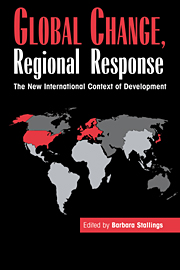Book contents
- Frontmatter
- Contents
- List of tables and figures
- List of contributors
- Acknowledgments
- Abbreviations
- 1 Introduction: global change, regional response
- Part I Global changes
- 2 The third world and the end of the cold war
- 3 Capitalisms in conflict? The United States, Europe, and Japan in the post–cold war world
- 4 Global production systems and third world development
- 5 New global financial trends: implications for development
- 6 The “triumph” of liberal economic ideas in the developing world
- Part II Regional responses
- Part III Conclusions
- Index
4 - Global production systems and third world development
Published online by Cambridge University Press: 05 June 2012
- Frontmatter
- Contents
- List of tables and figures
- List of contributors
- Acknowledgments
- Abbreviations
- 1 Introduction: global change, regional response
- Part I Global changes
- 2 The third world and the end of the cold war
- 3 Capitalisms in conflict? The United States, Europe, and Japan in the post–cold war world
- 4 Global production systems and third world development
- 5 New global financial trends: implications for development
- 6 The “triumph” of liberal economic ideas in the developing world
- Part II Regional responses
- Part III Conclusions
- Index
Summary
Over the past several decades, the world economy has undergone a fundamental shift toward an integrated and coordinated global division of labor in production and trade. In the 1950s and 1960s, production tended to be organized within national boundaries. International trade consisted, to a large degree, of raw materials flowing from the periphery to the industrialized core of the world economy, while manufactured exports were sent by U.S., European, and Japanese firms from their home bases to all corners of the globe. Direct foreign investment in manufacturing emerged as a response to the protectionist policies implemented by core and peripheral nations alike that wished to diminish the foreign exchange drain of an excessive reliance on imports and augment the employment benefits from locally based production.
Today the most dynamic industries are transnational in scope. Modern industrialization is the result of an integrated system of global trade and production. Open international trade has encouraged nations to specialize in different branches of manufacturing and even in different stages of production within a specific industry. This process, fueled by the explosion of new products and technologies since World War II, has led to the emergence of a global manufacturing system in which production capacity is dispersed to an unprecedented number of developing as well as industrialized countries.
New patterns of specialization between countries entail the fragmentation and geographic relocation of manufacturing processes on a global scale in ways that slice through national boundaries.
- Type
- Chapter
- Information
- Global Change, Regional ResponseThe New International Context of Development, pp. 100 - 142Publisher: Cambridge University PressPrint publication year: 1995
- 164
- Cited by



